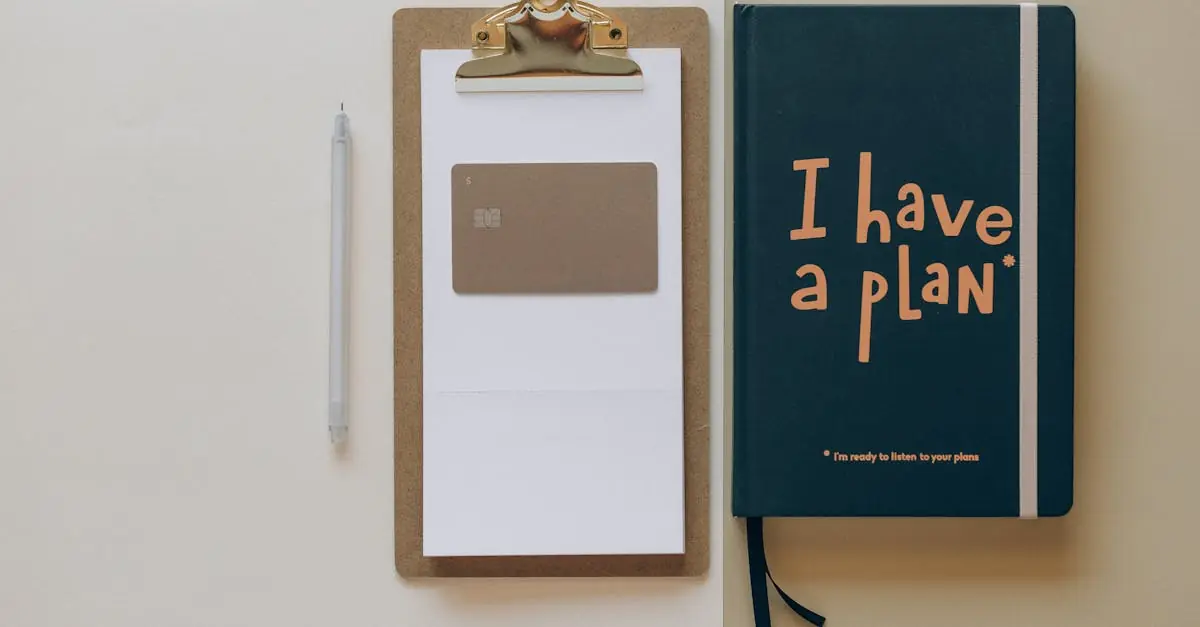In a world where chaos reigns supreme, an optimized planner setup is like finding the holy grail of productivity. Imagine having your life organized in a way that even your to-do list feels like a walk in the park. With the right planner setup, he can turn the overwhelming into the manageable and the mundane into the extraordinary.
Table of Contents
ToggleUnderstanding Optimized Planner Setup
An optimized planner setup plays a crucial role in enhancing productivity. It helps individuals manage tasks efficiently and promotes a well-structured approach to daily activities.
Importance of an Optimized Planner
Optimized planners address the chaos of modern life. They provide clarity by breaking down tasks into achievable steps. Organization through planners fosters accountability, leading to better time management. Prioritization becomes evident when tasks are visually represented. Clarity aids in reducing stress, as knowing what needs attention simplifies decision-making. Improved focus occurs as distractions diminish and goals take precedence.
Benefits of Using a Planner
Using a planner offers numerous advantages to users. Enhanced productivity stems from clear workflow charts and outlines. Consistent use cultivates habits that align with long-term objectives. Planners facilitate tracking of progress, enabling adjustments when necessary. Increased motivation arises from tangible representations of accomplishments. Many notice a reduction in procrastination when they maintain schedules through planners. By integrating daily tasks with larger goals, users find a sense of purpose in their activities.
Key Elements of an Optimized Planner Setup
An optimized planner setup includes essential components that enhance productivity and streamline daily tasks. By focusing on formats and tools, individuals can tailor their planners to meet specific needs.
Choosing the Right Planner Format
Selecting an appropriate planner format significantly impacts organization. Options like digital planners offer flexibility through app-based features, while physical planners bring tactile engagement. Bullet journals provide creative freedom, allowing personalization with drawings and colors. Daily, weekly, or monthly layouts cater to different planning styles based on task volume and urgency. Determining personal preferences helps in establishing an effective routine that fosters accountability.
Essential Tools and Supplies
Incorporating the right tools and supplies elevates planning experiences. Pens in various colors enhance visual appeal while aiding in categorization of tasks. Stickers and washi tape add creative flair that promotes engagement. Highlighters assist in prioritizing tasks, ensuring immediate attention to important deadlines. Additionally, utilizing sticky notes provides a quick way to jot down reminders without cluttering the main planner. These tools collectively contribute to a productive setup that aligns with long-term objectives.
Tips for Creating an Effective Setup
Creating an effective planner setup requires attention to detail. Consider how the planner layout fits personal preferences and practical needs.
Customizing Your Planner Layout
Explore various layouts to find what resonates. Many individuals prefer daily layouts for detailed organization while others opt for weekly formats for a broader view. Some users enjoy bullet journaling for customized creativity. Adjusting sections to include priorities or deadlines enhances visibility. Visual elements, like color coding, can simplify navigation. Using tabs or bookmarks ensures easy access to frequently referenced pages.
Setting Realistic Goals and Priorities
Establishing achievable goals is essential for a productive planner. Begin by defining short-term and long-term objectives that align with personal values. Breaking larger tasks into smaller, manageable steps keeps progress moving. Prioritize tasks daily by identifying the most urgent items. Consider deadlines and energy levels when organizing tasks. Reflect regularly on goals to ensure they remain attainable and relevant. Tracking accomplishments motivates ongoing productivity while reinforcing focus.
Common Mistakes to Avoid
An optimized planner setup requires attention to detail to avoid pitfalls that hinder productivity.
Overcomplicating Your Setup
Complexity often leads to confusion. Users may integrate too many elements into their planners, overwhelming themselves rather than enhancing organization. Stick to the basics; only include essential features that aid productivity. For instance, a simple color-coding system can improve task prioritization without clutter. Individuals should also avoid excessive embellishments that distract from core tasks. Maintaining a clear focus ensures more manageable planning and clearer execution.
Neglecting Flexibility
Flexibility in a planner setup becomes crucial for adaptation. Rigid structures may restrict users from adjusting to changing circumstances. Consider incorporating adjustable layouts or varying formats to accommodate workflow changes. Allow room for spontaneity in daily tasks; this can reduce stress during unforeseen events. Regularly evaluate and adjust setups to align with evolving priorities. By fostering a flexible approach, individuals enhance the effectiveness of their planners, ensuring they meet both immediate needs and long-term goals.
An optimized planner setup is more than just a tool; it’s a pathway to achieving personal and professional goals. By tailoring the planner to individual needs and preferences, users can streamline their tasks and enhance their productivity. The right planner format combined with essential tools transforms chaos into clarity, making daily challenges feel manageable.
Regularly assessing and adjusting the planner ensures it remains relevant and effective in meeting changing priorities. Embracing flexibility allows for spontaneous adjustments, keeping the planning process engaging and purposeful. Ultimately, a well-structured planner setup not only organizes tasks but also inspires motivation and accountability, paving the way for success.








